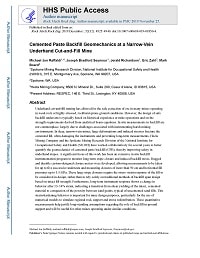Mining Publication: Cemented Paste Backfill Geomechanics at a Narrow-Vein Underhand Cut-and-Fill Mine
Original creation date: December 2019
Authors: M Raffaldi, J Seymour, J Richardson, E Zahl, M Board
Underhand cut-and-fill mining has allowed for the safe extraction of ore in many mines operating in weak rock or highly stressed, rockburst-prone ground conditions. However, the design of safe backfill undercuts is typically based on historical experience at mine operations and on the strength requirements derived from analytical beam equations. In situ measurements in backfill are not commonplace, largely due to challenges associated with instrumenting harsh mining environments. In deep, narrow-vein mines, large deformations and induced stresses fracture the cemented fill, often damaging the instruments and preventing long-term measurements. Hecla Mining Company and the Spokane Mining Research Division of the National Institute for Occupational Safety and Health (NIOSH) have worked collaboratively for several years to better quantify the geomechanics of cemented paste backfill (CPB), thereby improving safety in underhand stopes. A significant focus of this work has been an extensive in situ backfill instrumentation program to monitor long-term stope closure and induced backfill stress. Rugged and durable custom-designed closure meters were developed, allowing measurements to be taken for up to five successive undercuts and measuring closures of more than 50 cm and horizontal fill pressures up to 5.5 MPa. These large stope closures require the stress–strain response of the fill to be considered in design, rather than to rely solely on traditional methods of backfill span design based on intact fill strength. Furthermore, long-term instrument response shows a change in behavior after 13–14% strain, indicating a transition from shear yielding of the intact, cemented material to compaction of the porosity between sand grains, typical of uncemented sand fills. This strain-hardening behavior is important for mine design purposes, particularly for the use of numerical models to simulate regional rock support and stress redistribution. These quantitative measurements help justify long-standing assumptions regarding the role of backfill in ground support and will be useful for other mines operating under similar conditions.
